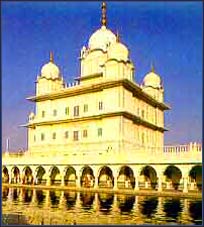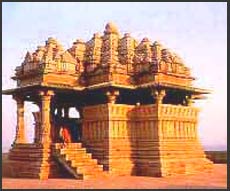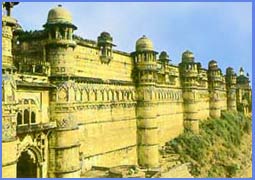| Destinations
|
|||
 Gwalior is a city with a dramatic, colourful history that goes back over a millennia. It's legendary beginning stems from a meeting between a warrior called Suraj Sen and a hermit, Gwalipa, who lived on the hilltop where the fort stands. It is said the hermit cured Suraj Sen of an incurable disease, who as a gesture of gratitude founded Gwalior.
Gwalior is a city with a dramatic, colourful history that goes back over a millennia. It's legendary beginning stems from a meeting between a warrior called Suraj Sen and a hermit, Gwalipa, who lived on the hilltop where the fort stands. It is said the hermit cured Suraj Sen of an incurable disease, who as a gesture of gratitude founded Gwalior.
Over the centuries, Gwalior became a city of immense importance and was a continual scene of intrigue and clashes with neighbouring powers. It's strategic location was patronised by many mighty rulers, making it the birthplace of many dynasties, each leaving its own indelible mark over the city. Modern Gwalior is a cauldron of diverse cultures with a distinct princely aura of the days gone by.
Sightseeing |
More on M.P. • Overview Cities • Bhopal • Indore • Ujjain • Sanchi • Orccha • Shivpuri • Kanha
Travelogues Heritage • Erotic Art • Khajuraho
Wildlife |
||
Gujari Mahal- Within the Fort are some marvels of medieval architecture. The 15th century, Gujari Mahal is a monument to the love of Raja Mansingh Tomar for the intrepid Mrignayani a tribal Gujar Queen. The outer structure of the Gujari Mahal has survived in an almost total state of preservation; the interior has been converted into an Archaeological Museum housing rare antiquities, some of them dating back to the 1st century A.D.
Teli Ka Mandir and Sas Bahu Ka Mandir - The 9th century Teli Ka Mandir, towering a 1000 ft high, is a Pratihara Vishnu temple of a unique blending of architectural styles. Also dedicated to Vishnu is the graceful Sas-Bahu Ka Mandir, built in the 11th century. Jai Vilas Palace and Museum - A splendour of a different kind exists in the Jai Vilas Palace, current residence of the Scindia family. Some 35 rooms have been made into the Jiwaji Rao Scindia Museum, and in these rooms, so evocative of a regal lifestyle the past comes alive. Jai Vilas is an Italianate structure which combines the Tuscan and Corinthian architectural modes. The imposing Darbar Hall has two central chandeliers weighing a couple of tonnes, and hung only after ten elephants had tested the strength of the roof. Ceilings picked out in gilt, heavy draperies and tapestries, fine persian carpets and antique furniture from France and Italy are features of these spacious rooms. The Scindia Museum offers an unparalleled glimpse into the rich culture and lifestyle of princely India.
The Tansen Music Festival: Every year in Novermber and December, renowned artists gather at Gwalior to pay tribute to the legend of music - Mian Tansen. Ghaus Mohammed's Tomb - The Sandstone mausoleum of the Afghan prince Ghaus Mohammed, is also designed on early Mughal lines. Near Gwalior Shivpuri: (112 kms. from Gwalior) This quaint little town used to be the summer capital of the Scindia rulers of Gwalior. A natural choice obviously, with its luxuriant forests and hilly environs. The Madhav National Park is home to a variety of avifauna. There are beautiful carved cenotaphs erected in memory of the Scindia rulers. Also worth a visit are the Madhav Vilas Palace, George Castle, Bhadaiya Kund and Sakhya Sagar Boat Club. Datia: (69 kms. from Gwalior). Known in Mahabharata as Daityavakra, Datia is known for its seven-storied palace of Raja Bir Singh Deo. This structure is a unique example of 17th century architecture. And if you happen to be a temple frequenter, do visit the Gopeshwar temple. Orchha: (120 kms. from Gwalior). Lying on the road to Khajuraho, Orchha is famous for its palaces and temples built in the 17th and 18th centuries. Once the capital of the Bundela Rajputs, later under Mughal rule, some of its palaces contain murals of the Bundela school. Particularly worth visiting are the Jehangir Mahal, built to commemorate Emperor Jehangir's visit in the 17th century; the Chaturbhuj Mandir and the Laxmi Mandir. Getting There: Accommodation:There is every kind of accommodation to suit all budgets. This includes the Welcomegroup Usha Kiran Palace. Then there is Hotel Tansen belonging to M.P. Tourism. Other good hotels include the Hotel Gwalior Regency and Metro Hotel. Information: Courtesy Government of India
|
|||
Editor: Romola Butalia (c) India Travelogue. All rights reserved. |
|||

 Man Mandir Palace- Built between 1486 and 1517 by Raja Mansingh. Vast chambers with fine stone screens were once the music halls, and behind these screens, the royal ladies would learn music from the great masters of the day. A superbly mounted Son-et-Lumiere here brings it all alive every evening.
Man Mandir Palace- Built between 1486 and 1517 by Raja Mansingh. Vast chambers with fine stone screens were once the music halls, and behind these screens, the royal ladies would learn music from the great masters of the day. A superbly mounted Son-et-Lumiere here brings it all alive every evening.
 Tansen's Tomb - A pillar of Hindustani classical music, the great Tansen, one of the `nine jewels' of Akbar's court lies buried in Gwalior. The memorial to this great musician has a pristine simplicity about it, and is built in the early Mughal architectural style. More than a monument, the tomb is part of Gwalior's living cultural heritage;
Tansen's Tomb - A pillar of Hindustani classical music, the great Tansen, one of the `nine jewels' of Akbar's court lies buried in Gwalior. The memorial to this great musician has a pristine simplicity about it, and is built in the early Mughal architectural style. More than a monument, the tomb is part of Gwalior's living cultural heritage;